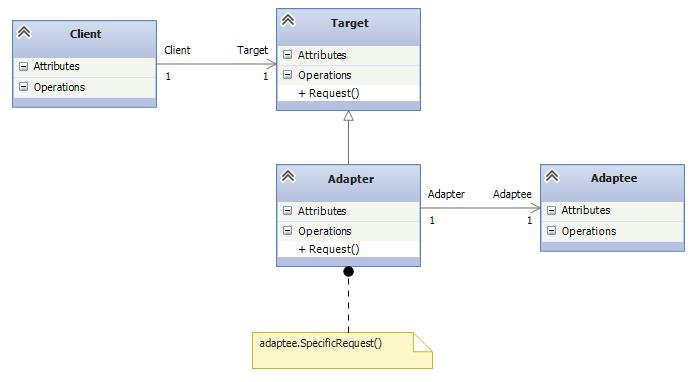模式定义
适配器模式(Adapter Pattern) :将一个接口转换成客户希望的另一个接口,适配器模式使接口不兼容的那些类可以一起工作,其别名为包装器(Wrapper)。适配器模式既可以作为类结构型模式,也可以作为对象结构型模式。如果适配者(三方类库修改)只需要修改适配器
UML类图

- 目标抽象类(Target) 客户需要用的特定接口
- 适配器类(Adapter) 关联适配者类,实现目标抽象类接口
- 适配者类(Adaptee) 被适配的角色,它定义了一个已经存在的接口,这个接口需要适配(一般只三方类库)
- 客户端(Client) 针对目标抽象类进行编程
代码结构
public static class AdapteeApp
{
public static void Run()
{
Target target = new Adapter();
target.Request();
}
}
public class Target
{
public virtual void Request()
{
Console.WriteLine("Called Target Request()");
}
}
public class Adapter :Target
{
private Adaptee _adaptee = new Adaptee();
public override void Request()
{
_adaptee.SpecificRequest();
}
}
public class Adaptee
{
public void SpecificRequest()
{
Console.WriteLine("Called specificRequest()");
}
}
情景模式
在开发中用到适配者模式,一般指引入第三方类库,且第三方类库的接口并非完全一直。这里以缓存操作为例,项目刚开始缓存存在内存,随着项目数据的增多决定引入Redis做缓存,然而Redis的缓存操作接口并非与本系统操作接口完全一致,这里通过适配者模式解决(这点也体现依赖倒置:高层不应依赖底层,应依赖接口)。
public static class AdapteeApp
{
public static void Run()
{
CacheManage cache1 = new DictionaryCache();
cache1.Set("name", "LoveTomato");
Console.WriteLine(cache1.Get("name").ToString());
CacheManage cache2 = new RedisCacheAdapter();
cache2.Set("name", "LoveTomato");
Console.WriteLine(cache2.Get("name").ToString());
}
}
public interface CacheManage
{
object Get(string key);
void Set(string key, object value);
bool IsExist(string key);
void Remove(string key);
void Clear();
}
public class DictionaryCache : CacheManage
{
private Dictionary<string, object> _dic = new Dictionary<string, object>();
public void Clear()
{
_dic.Clear();
}
public object Get(string key)
{
object obj = null;
if (this.IsExist(key))
{
obj = _dic[key];
}
return obj;
}
public bool IsExist(string key)
{
bool b = false;
if (_dic.Keys.Contains(key))
{
b = true;
}
return b;
}
public void Remove(string key)
{
if (this.IsExist(key))
{
_dic.Remove(key);
}
}
public void Set(string key, object value)
{
_dic[key] = value;
}
}
public class RedisCacheAdapter : CacheManage
{
private RedisCache redisCache = new RedisCache();
public void Clear()
{
redisCache.Empty();
}
public object Get(string key)
{
return redisCache.Get(key);
}
public bool IsExist(string key)
{
return redisCache.IsSet(key);
}
public void Remove(string key)
{
redisCache.Delete(key);
}
public void Set(string key, object value)
{
redisCache.Set(key, value);
}
}
public class RedisCache
{
public void Empty()
{ }
public object Get(string key)
{
return null;
}
public void Set(string key, object value)
{ }
public bool IsSet(string key)
{
return false;
}
public void Delete(string key)
{ }
}